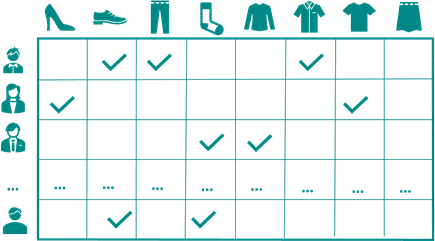In today’s dynamic retail environment, market basket analysis offers business owners a strategic way to boost sales. Whether it’s a response to a dip in revenue or adapting to a new store location, even a minor decrease in sales can trigger financial concerns.
Yet, achieving your sales targets often just marks the beginning. The desire to sustain or even increase that momentum can lead to escalated promotional efforts, ultimately raising customer acquisition costs. Many businesses turn to upselling and cross-selling, but this approach risks customer fatigue or loss to competitors.
So, how can businesses overcome these challenges, attract new customers, and reengage existing ones? Market Basket Analysis (MBA) offers a strategic solution.
Understanding Market Basket Analysis
Market Basket Analysis is a data mining technique that predicts future purchase patterns based on current buying behaviors. It involves observing commonly purchased items together and uses ‘if-then’ rules to reveal product relationships, measured by support, confidence, and lift metrics.
For example, if customers frequently buy peanut butter and jelly together, the rule would state: If a customer buys peanut butter, they are likely to buy jelly as well.
Imagine entering a grocery store to buy ingredients for taco night. You pick up tortillas and head to the condiments aisle for salsa. Right there, you find taco seasoning and taco shells — the exact items you need but hadn’t thought of yet. This isn’t by chance; it’s the result of strategic product placement based on market basket analysis. Online stores can adopt this strategy by bundling such items or suggesting them during checkout.
Delving Deeper into Market Basket Analysis
Retail managers use market basket analysis to uncover purchase patterns that suggest a natural affinity between products. This knowledge can significantly impact promotional strategies aimed at boosting sales or improving overall revenue.
Take the common pairing of burgers and fries in fast food chains. It’s almost expected to purchase fries and a drink with a burger. Recognizing this, restaurants often offer meal sets at a discounted rate, capitalizing on the customer’s tendency to buy these items together. Even if a customer initially wants only a burger, the bundled meal offer often proves too good to pass up, providing better value for just a small additional cost.

Strategic Application of Market Basket Analysis
E-commerce platforms have unique opportunities to leverage MBA due to their digital nature, which allows for seamless data collection and analysis. Here are some strategies e-commerce businesses can employ:
- Personalized Product Recommendations: Online stores can use MBA to suggest products that complement what a customer has already added to their cart. This not only enhances the shopping experience by making relevant suggestions but also increases the average order value.
- Dynamic Bundling: By analyzing products that are frequently bought together, e-commerce sites can offer these as pre-packaged bundles at a discounted rate. This strategy simplifies the shopping process for customers and effectively increases sales volumes.
- Targeted Email Marketing: With insights from MBA, retailers can send personalized email campaigns that promote products related to a customer’s previous purchases. This targeted approach is often more effective than generic marketing blasts.
- Optimizing Store Layouts: Even in digital storefronts, the arrangement of products can influence purchasing behavior. Using MBA, e-commerce businesses can strategically place related products in close proximity, even within digital catalogs, to increase visibility and likelihood of purchase.
- Enhanced Advertising Strategies: Market Basket Analysis can significantly refine your advertising efforts. By understanding the products that frequently co-purchase, you can create targeted ads that feature these combinations. For example, if data shows that customers who buy gaming consoles often purchase specific types of games, you can create ad campaigns that target console buyers with those games. This not only increases the relevance of your ads but also the likelihood of higher conversion rates. Utilizing platforms like Google Ads or Facebook Ads, you can directly target audiences who have shown interest in one product with ads for its complementary products.
- Inventory Management: MBA can help predict which products are likely to be purchased together, allowing businesses to manage their stock levels more efficiently. This ensures that high-demand products are always available, preventing stock-outs and lost sales.
Key Metrics of Market Basket Analysis
Understanding the three fundamental metrics of MBA—support, confidence, and lift—is crucial for effectively implementing this analysis:
- Support: This metric calculates the proportion of transactions that include the item set compared to all transactions within the dataset. A higher support value indicates that the item set frequently appears in transactions, making it a potentially important combination for promotional strategies. For example, if ‘milk’ and ‘cookies’ appear together in 100 out of 1000 transactions, the support is 10%.
- Confidence: Confidence measures the likelihood of purchasing an item B given that item A has already been purchased. This metric helps determine the strength of the implication found in the rules. For instance, if 80 out of 100 transactions that include milk also include cookies, the confidence of the rule ‘if milk, then cookies’ is 80%.
- Lift: Lift indicates the strength of an association between items, compared to the likelihood of the items being purchased randomly. A lift value greater than 1 suggests that the items are more likely to be bought together than separately. For example, if cookies are bought with milk 3 times more frequently than cookies are bought alone, the lift for ‘if milk, then cookies’ is 3. This suggests a strong positive relationship between milk and cookies.
Real-World Success Stories
Several leading e-commerce giants have effectively used MBA to drive their strategies:
- Amazon’s “Frequently Bought Together” Recommendations: Amazon uses MBA to power its recommendation engine, showing users what other buyers purchased alongside the item they’re viewing. This not only improves user experience by simplifying the shopping process but also increases the average order value.
- Walmart’s Strategic Product Placement: Walmart analyzes basket data to optimize the layout of their physical and online stores, ensuring products that are often bought together are placed near each other, facilitating cross-selling.
According to a report by McKinsey & Company, companies that utilize advanced analytics like MBA can achieve a 60% increase in their operational margins. Moreover, a Harvard Business Review article highlights that businesses employing such analytics report up to a 30% increase in online sales.
Identifying and Overcoming Challenges
While MBA offers substantial benefits, it also comes with its challenges. One of the main hurdles is the vast amount of data that needs to be processed. This can be overwhelming for businesses without the right tools or expertise.
Another challenge is ensuring the relevance of the recommendations. With changing trends and customer preferences, what works today might not work tomorrow. Therefore, continuous data updates and analysis are crucial.
Conclusion
Market Basket Analysis is not just a technical tool but a strategic asset for e-commerce businesses. By effectively understanding and implementing MBA, businesses can not only increase revenue but also offer a shopping experience that keeps customers returning. The key lies in staying curious and analytical, continually adapting to the competitive e-commerce landscape.
